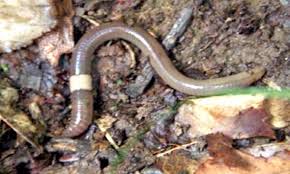 Forest IPM Home | Historical Projects | Invasive Worms | Entomology Home |
| Invasive Worms |
Most earthworms present in the northeast are considered exotic. They were introduced in the 18th & 19th centuries via early settlers or through trade of soil and horticultural materials transported from Europe and Asia. New ones are continuing to be introduced spreading through fishing bait, compost and gardening supplies and plant exchanges. In
annual systems earthworms seem to enhance soil fertility through rich
castings,
soil porosity facilitation, and enhanced nitrogen and carbon cycling.
In
perennial ecosystems such as forests they pose an ecosystem health
threat.
They consume the organic top (duff) layers of soil. The
loss is linked to the reduction in biodiversity often
observed in invaded
forests. This layer includes most of the nutrient exchange networks
involving
mycelium and roots. It is also where many seeds germinate. The
change in
forest floor structure and plant diversity also diminishes the habitat
for
other species such as ground nesting birds, mammals, invertebrates, and
woodland salamanders. For three years we have gathered data from 35 sites in five states (VT, NH, MA, NY, CT), in five USDA cold hardiness zones (4a, 4b, 5a, 5b, 6a). We recorded canopy and understory species diversity, maple seedling and sapling numbers, exotic plant presence, and earthworm species and abundance. Our findings indicate that worm presence is in direct relationship to forest damage levels. |  Adult Amynthas |
A new and
highly destructive group of earthworm species is invading Vermont forests.
These hail from Japan. Currently there are three Asian species that appear to
threaten northeastern hardwood forests: Amynthas agrestis, Amynthas tokioensis and
Metaphire hilgendorfi. They are known as snake worms or jumper worms.
These worms appear to threaten regeneration of canopy and understory species.
They produce very distinctive castings which have the appearance of loose
coffee grounds. Further research will be conducted to determine solutions which can protect forests from these worms, in particular the most damaging species of snake worms (Amynthas) and night crawlers (Lumbricus terrestris). In the interim, forest management plans can include strategies to minimize vector exposure: eliminate fishing bait refuse, minimize movement of horticultural materials andinspect all nursery species before planting for the presence of worms or signs, such as their characteristic castings. To determine whether you have these earthworms in your forest look for casting piles known as middens (Amynthas) and for holes and tunnels (Lumbricus). As a first warning sign for presence of both species, look for diminished duff and understory plant cover. There are several links below that can help you identify worms and their signs. If you suspect you have invasive
worms, please view the information below for how to sample and identify
them. | |
| Presentations Invasive Earthworms in Northeastern Sugarbushes - C.Frank Sullivan, B.L. Parker, M. Skinner, J. Gorres, Chittenden County Sugarmakers Association Annual Meeting, January 10, 2018 Effects of exotic earthworms on maple forests in northeastern states - The International Maple Syrup Institute - North Amercian Maple Syrup Council Annual Meeting held on October 23-25, 2017 in Quebec Worm Woes - C. Frank Sullivan, B.L. Parker, M. Skinner, J. Gorres Tri-State Greenhouse IPM Workshop, January 4-7, 2017, Manchester, ME, Durham, NH & Burlington, VT Worm ID Resources Jumping Worm Id Card: http://dnr.wi.gov/topic/forestmanagement/documents/pub/FR-550a.pdf Earthworm Taxonomic Key: https://www.naturewatch.ca/wormwatch/how-to-guide/identifying-earthworms/ Key to Asian Earthworm Invaders Chang, C.-H., Snyder, B.A., Szlavecz, K. (2016) Asian pheretimoid earthworms in North America north of Mexico: An illustrated key to the genera Amynthas, Metaphire, Pithemera, and Polypheretima (Clitellata: Megascolecidae). Zootaxa 4179(3), 495–529 Additional Information Amynthas agrestis: The Crazy Snake Worm: http://blog.uvm.edu/jgorres/amynthas/ Great Lakes Worm Watch: http://www.nrri.umn.edu/worms/ Invasive Eathworms in the Northeast USA & the Horticulture Industry:https://www.uvm.edu/~entlab/Greenhouse%20IPM/Workshops/2014/InvasiveEarthworms.pdf Is there another Invasive Pest in your Sugarbush? December, 2015 issue of the Maple Digest: Click HERE Jumping Worm Info Brochure: http://dnr.wi.gov/topic/forestmanagement/documents/pub/FR-550.pdf Vermont Invasives - Worms: http://www.vtinvasives.org/other-invasives/earthworms Funding Sources We thank the support they have received from the North American Maple Syrup Council, Chittenden County Sugarmakers Assoc., and Univ. of Vermont College of Agriculture & Life Sciences. | |
Last update: October 2019